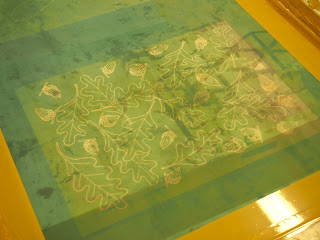
It was an evening workshop, which didn't appeal to me but I understand that this is convenient for others who work during the day. I was a bit miffed when I ended up parking in a multi storey car park close by and then spotted as I drove up the ramp to the barrier that it was going to cost £12 for the 3 hours which I thought was extortionate but it was a bit late to change my mind by that stage.
 When I arrived most people were already seated around the waiting area. A few more of the group arrived then we were introduced to our host Sumiko Eadon who is one of the artists in resident.
When I arrived most people were already seated around the waiting area. A few more of the group arrived then we were introduced to our host Sumiko Eadon who is one of the artists in resident.Firstly we were taken a tour of the workshop. I found the space to be airy, with excellent light and a very calming atmosphere which I found refreshing. We were shown the various areas of the workshop and then taken to the collective area we would be working in. Sumiko then provided for us a short demonstration on the various ways to achieve a mono print.
 She made it look so easy and effortless, but I guess this is because of the years of experience she has. I have always found printing intriguing, but it's one of those processes that is messy and time consuming. I think you need to know what you want to achieve before you start, but you also need to know what is achievable, a bit like a chicken and egg conundrum. Having said that, once I got started and I began to understand the process a little, I started to relax and enjoy myself more. Working in mono print means you ink up a metal or plastic plate then you can either draw into the surface like Amelia Kirk is doing here on the right. Alternatively you can lay things onto your plate top it with dampened paper then roll through the press.
She made it look so easy and effortless, but I guess this is because of the years of experience she has. I have always found printing intriguing, but it's one of those processes that is messy and time consuming. I think you need to know what you want to achieve before you start, but you also need to know what is achievable, a bit like a chicken and egg conundrum. Having said that, once I got started and I began to understand the process a little, I started to relax and enjoy myself more. Working in mono print means you ink up a metal or plastic plate then you can either draw into the surface like Amelia Kirk is doing here on the right. Alternatively you can lay things onto your plate top it with dampened paper then roll through the press. |
| Feathers and twig mono print by Phiona Richards |
 |
| Oak leaf and Acorn screen ready for printing |
I did enjoy this technique and would perhaps like to learn more about it. I'm wondering whether there is an easier way to do it at home. I'm sure I've seen ideas on Pinterest. I must explore this further.
My screen was supposed to be a repeat pattern but after the initial drawing and preparing it for photoshop, it became very time consuming trying to make the background one colour. I just wasn't sure what would be picked up in the background and I wanted it to be a line drawing. Screen printing is a great technique to produce multi prints. I know you can use it on fabric as well.
 |
| Two tone mono print |
to do flocking and foiling. It was quite a difficult one to demonstrate as the screens we had prepared weren't really open enough to squeeze the adhesive through but through grit and determination Kelly managed it. Once the adhesive was dry she placed the foiling plastic over the design and placed it in a heat press machine for 15 seconds. Once out of the machine she waited for the foil to cool before peeling the excess back. The effect was shiny and so attractive, we ladies love our glitz and glamour. Apparently this is something you can replicate at home using a glue stick and house iron.
I had a go at this technique by using a fine brush and drew Rare Notions onto a piece of calico. The result was basic but useable. I think I will work into it with stitch and other embellishments.
All in all it was a very informative evening. I would have like to have a go at lino cutting but as I have booked myself on a two hour evening course carving rubber stamps on Friday I wasn't too bothered
More images from the evening can be found here

No comments:
Post a Comment